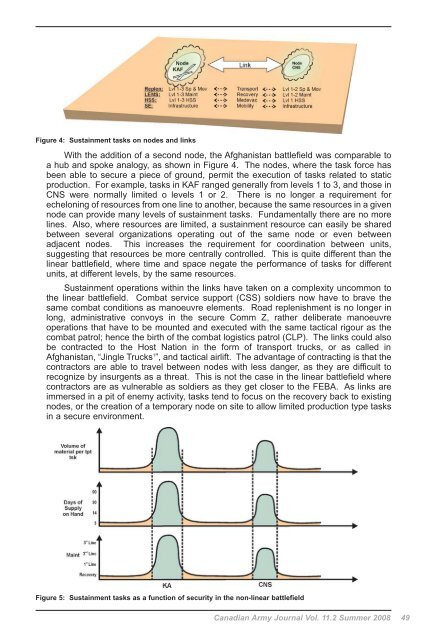Practical Sustainment Concepts for the Non-Linear Battlespace
Practical Sustainment Concepts for the Non-Linear Battlespace
Practical Sustainment Concepts for the Non-Linear Battlespace
Create successful ePaper yourself
Turn your PDF publications into a flip-book with our unique Google optimized e-Paper software.
Figure 4: <strong>Sustainment</strong> tasks on nodes and links<br />
With <strong>the</strong> addition of a second node, <strong>the</strong> Afghanistan battlefield was comparable to<br />
a hub and spoke analogy, as shown in Figure 4. The nodes, where <strong>the</strong> task <strong>for</strong>ce has<br />
been able to secure a piece of ground, permit <strong>the</strong> execution of tasks related to static<br />
production. For example, tasks in KAF ranged generally from levels 1 to 3, and those in<br />
CNS were normally limited o levels 1 or 2. There is no longer a requirement <strong>for</strong><br />
echeloning of resources from one line to ano<strong>the</strong>r, because <strong>the</strong> same resources in a given<br />
node can provide many levels of sustainment tasks. Fundamentally <strong>the</strong>re are no more<br />
lines. Also, where resources are limited, a sustainment resource can easily be shared<br />
between several organizations operating out of <strong>the</strong> same node or even between<br />
adjacent nodes. This increases <strong>the</strong> requirement <strong>for</strong> coordination between units,<br />
suggesting that resources be more centrally controlled. This is quite different than <strong>the</strong><br />
linear battlefield, where time and space negate <strong>the</strong> per<strong>for</strong>mance of tasks <strong>for</strong> different<br />
units, at different levels, by <strong>the</strong> same resources.<br />
<strong>Sustainment</strong> operations within <strong>the</strong> links have taken on a complexity uncommon to<br />
<strong>the</strong> linear battlefield. Combat service support (CSS) soldiers now have to brave <strong>the</strong><br />
same combat conditions as manoeuvre elements. Road replenishment is no longer in<br />
long, administrative convoys in <strong>the</strong> secure Comm Z, ra<strong>the</strong>r deliberate manoeuvre<br />
operations that have to be mounted and executed with <strong>the</strong> same tactical rigour as <strong>the</strong><br />
combat patrol; hence <strong>the</strong> birth of <strong>the</strong> combat logistics patrol (CLP). The links could also<br />
be contracted to <strong>the</strong> Host Nation in <strong>the</strong> <strong>for</strong>m of transport trucks, or as called in<br />
Afghanistan, “Jingle Trucks1 ”, and tactical airlift. The advantage of contracting is that <strong>the</strong><br />
contractors are able to travel between nodes with less danger, as <strong>the</strong>y are difficult to<br />
recognize by insurgents as a threat. This is not <strong>the</strong> case in <strong>the</strong> linear battlefield where<br />
contractors are as vulnerable as soldiers as <strong>the</strong>y get closer to <strong>the</strong> FEBA. As links are<br />
immersed in a pit of enemy activity, tasks tend to focus on <strong>the</strong> recovery back to existing<br />
nodes, or <strong>the</strong> creation of a temporary node on site to allow limited production type tasks<br />
in a secure environment.<br />
Figure 5: <strong>Sustainment</strong> tasks as a function of security in <strong>the</strong> non-linear battlefield<br />
Canadian Army Journal Vol. 11.2 Summer 2008 49







![La modularite dans l'Armee de terre canadienne [pdf 1.6 MB]](https://img.yumpu.com/17197737/1/188x260/la-modularite-dans-larmee-de-terre-canadienne-pdf-16-mb.jpg?quality=85)









